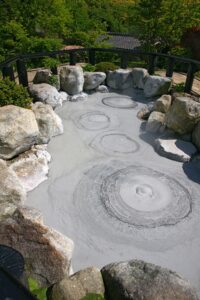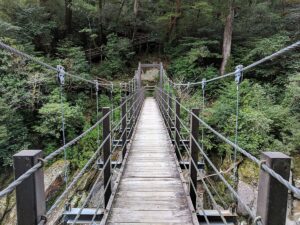Overview (history, characteristics, attractions)
Dakikaeri Gorge is a scenic valley located in Senboku City (formerly Kakunodate Town), Akita Prefecture. It is characterized by a deep V-shaped valley, a clear stream, and natural forests of beech and maple trees lining the sheer rock faces, and is known as one of the prefecture's most famous spots for its autumn foliage. The valley is equipped with walking paths, observation decks, and suspension bridges, and as it displays different faces throughout the seasons, it is a great spot for hiking, photography, and nature observation. It has long been a popular scenic spot among locals, and is often included in tourist routes along with the Kakunodate Samurai Residences and Lake Tazawa.
Highlights
- Valley Promenade: Walk along the well-maintained promenade and enjoy the view of the mountain stream, cliffs, and huge rocks up close. The scenery created by the sunlight filtering through the trees and the moss-covered rocks is beautiful.
- Suspension bridges and observation points: From the suspension bridges spanning the valley and several observation decks, you can get a panoramic view of the stream and the surrounding dense forest. There are many photo spots where you can capture the scenery of the four seasons.
- Fresh greenery and autumn leaves: The vibrant fresh greenery of spring and the fiery red leaves of autumn are especially popular. In years when the leaves change color early in autumn, the best time to see them is around mid-October.
- Winter scenery: The winter scenery created by accumulated snow, frozen waterfalls, and rock walls is rare, and you can enjoy the snowy scenery (however, there may be restrictions on access when there is snow).
- Bird and plant observation: The area around the valley is rich in flora and fauna, making it a great place for bird watching and observing seasonal flowers (such as wild mountain flowers in spring).
Access (nearest station, transportation, etc.)
- Nearest station: Kakunodate Station on the JR Tazawako Line and Akita Shinkansen.
- Train + Bus/Taxi: Approximately 15-25 minutes by taxi from Kakunodate Station (varies depending on traffic conditions). Buses run less frequently depending on the season and day of the week, so it is recommended to check in advance.
- By car: Accessible via the Akita Expressway and Tohoku Expressway. Approximately 15-25 minutes by car from the center of Kakunodate. Parking is available near the entrance (limited spaces available, and may be full during peak seasons).
- Long-distance access: From Tokyo, it takes about 3 hours to get to Kakunodate on the Akita Shinkansen (Komachi). It is also easily accessible from Akita City and Lake Tazawa, making it a great base for sightseeing.
Estimated stay (estimated time required)
- Round trip walk within the valley: Approximately 30 minutes to 1 hour (1 to 1.5 hours including photography and breaks).
- If you want to take your time observing nature and strolling around the area: about 1.5 to 2 hours.
- If you are sightseeing in addition to the townscape of Kakunodate and other spots, a half-day to full-day course is recommended.
Nearby spots
- Kakunodate Samurai Residences (Kakunodate Cherry Blossom Avenue): Famous for its historic buildings and spring cherry blossoms. About a 15-25 minute drive from Dakigaeri Valley.
- Lake Tazawa: One of the deepest lakes in Japan. Enjoy lakeside walks and sightseeing boat rides.
- Nyuto Onsenkyo: A hot spring resort nestled in the mountains where you can experience the atmosphere of a hidden hot spring. Convenient for day trips or overnight stays.
- Tazawako Plateau (skiing and hiking): An area where you can enjoy outdoor activities in every season.
Things to be aware of (crowds, manners, seasonal precautions, etc.)
- Crowds: The autumn foliage season (generally mid-October to early November) is particularly busy, and parking lots and promenades can get crowded. If you plan to visit early in the morning or on a weekday, you can enjoy a more leisurely view.
- Clothing and equipment: The walking trail includes stone steps, boardwalks, and muddy areas. We recommend comfortable walking shoes (such as trekking shoes) and cold/waterproof clothing. In summer, you'll need insect protection, and in winter, anti-slip clothing.
- Winter travel: When there is heavy snowfall or ice, the trails and some sections may be closed. Please check the Semboku City tourist information etc. beforehand to see if the trails are open.
- Nature Conservation and Manners: Please be sure to take your trash with you and avoid damaging plants and rocks. Do not enter areas other than designated ones or cross dangerous areas.
- Wild animals: As this is a mountainous area, there are certain wild animals (such as bears) living there. Avoid traveling alone early in the morning or late at night, and be sure to check local warning information just in case.
- Drones/Photography: When bringing or flying drones, please be mindful of the surrounding regulations and other visitors. Please check and obtain permission in advance.
Dakigaeri Valley is a natural spot where you can enjoy the changing faces of the seasons. Plan a day trip or overnight trip to visit the surrounding area, including Kakunodate, Lake Tazawa, and hot springs, for a fulfilling stay. Please check transportation options, park opening times, and road conditions in advance to ensure a safe trip.



